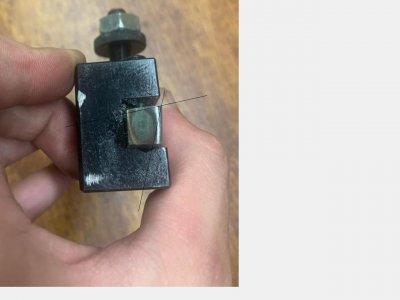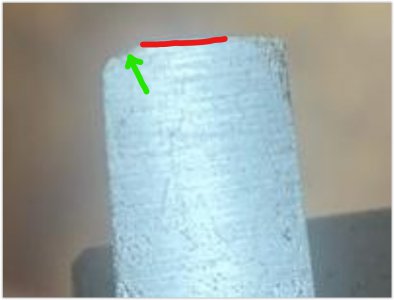It is very difficult to say where that half thou of movement is coming from but if I had to guess, I would suspect the spindle bearings are it. You have to remember that your lathe is built to a price point and the maker will use cheaper bearings. If you were to install accuracy-class bearings like ABEC-5's, it would be better. The cost for ABEC-5 bearings to fit your lathe would not be unreasonable; if you plan to keep your lathe then this might be something to consider. However, I suggest you put this on hold while you get the lathe aligned and leveled.
I actually have to disagree with you with regard to the headstock and spindle causing a poor finish; too many guys own that same lathe and can produce acceptable finishes. I think the tool you're using and possibly the material you're cutting is more likely the issue. This is a good thing, by the way, because I think we can definitely improve the tool. We'll get to the tool in a minute.
Putting an indicator on the headstock and pushing on the spindle tells you essentially nothing about the levelness of your lathe or anything else. There is a process to check and set the level of the lathe that I won't go into here because that is a HUGE discussion but you're going to be okay, it isn't hard to do. I suggest you start a new thread and ask the guys for advice on aligning the headstock and leveling the lathe.
You're right; you do have some side and end relief - thanks for the pics. A large nose radius does produce a nicer finish BUT it also deflects like crazy unless you take tiny cuts. Moreover, you are cutting with the tool mostly perpendicular to the work piece and the area adjacent to the nose radius is rubbing; that is where your poor finish is mostly coming from. In the screen shot below, the area of primary contact is in green and the area that is probably rubbing is in red:
View attachment 331674
On a turning tool, the area of contact matters but even more important is that that contact point must be the ONLY point in contact. Therefore, the shape of the tool matters. You are cutting with the end cutting edge, which is fine. However, too much of the end edge is touching the work and the tool is rubbing. Typically, rubbing results in a torn, rough surface and that is exactly what you're seeing.
Luckily, as Mark points out, fixing this is easy. You just need to learn to grind a better shape with the proper tool angles and you'll do just fine. To save my fingers
let me refer you to a write up that might help you. We also have a
huge thread going here that might be of interest to you.
You're going to be fine. Work on getting the lathe aligned and leveled, then come on over to the model tools thread and let's hash out the tool. You'll be up and running in no time.





